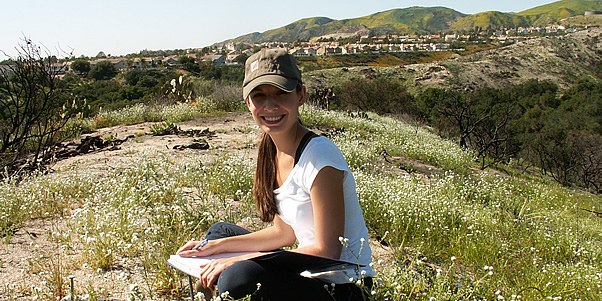Donít Go There!
What Looks Like Dirt Can Be a Biological Matrix
July 21, 2009
By Russ L. Hudson
Rebecca Hernandez walked into her future with a master’s in biology, but the research she conducted while at Cal State Fullerton — on invasive plants in coastal sage scrub ecosystems — continues this summer through a UC Riverside program. Her efforts could have long-term effects, possibly altering management practices in semiarid ecosystems around the world. The key: Don’t go where you don’t have to. What looks like common dirt can be full of protective life.
Hernandez hypothesized that breaks in the biological crust — a matrix of interlocking lichens, fungi, cyanobacteria, green algae, other bacteria and bryophytes on the soil’s surface — make it far easier for non-native plants to germinate because the crust acts as a shield, preventing invasive seeds from gaining a hold. The biocrust is no barrier to the seeds of native plants, however, “probably because they coevolved to penetrate the barrier," Hernandez said. Breaks also make the soil more vulnerable to erosion and allow water that has soaked into the soil to evaporate more quickly, cutting the time it can nurture plants.
Hernandez’s research in Limestone Canyons and Whiting Ranch Wilderness Park in southeast Orange County shows that the seeds of non-native plants germinate easily where the biological crust was broken, as it often is where hikers, off-road vehicles and mountain bikes have access.
Once established, non-natives, usually grasses with few natural predators to slow them, can overwhelm native vegetation. The loss of native vegetation reduces biodiversity because other plants and animals dependent on it diminish as well.
Next to loss of habitat, invasions by non-natives, called exotics, are the primary reason for loss of biodiversity, Hernandez explained, an assertion affirmed by a U.S. Geological Survey report that disturbance of biocrust has led to widespread ecological damage worldwide.
It can take five to 20 years for disturbed biocrust to re-form in most areas, and up to 250 years in the driest areas, the report says.
Hernandez supports the U.S.G.S. assertion that it is better for visitors to stay on established roads and trails. If established routes can’t be used, by work crews for example, they should travel in washes or on rocky surfaces as much as is feasible.
Hernandez’s continuing research of Mediterranean-type ecosystems, like coastal sage scrub, is being conducted with natural resources specialist Edith B. Allen, professor of plant ecology at UCR. As a Sally Casanova California Pre-Doctoral Scholar, a designation Herndandez earned in July 2008, she is eligible to conduct research at a doctoral-granting institution. After seeing Allen’s ecological work, Hernandez approached her about working together and won a pre-doctoral fellowship from UCR to fund her work there. She will apply to doctoral programs this fall and plans to start a program next year. She hopes to continue this avenue of research.
This spring, Hernandez won first place in the Graduate Women in Science regional competition among student researchers pursuing master's degrees. She will present her findings nationally at the Aug. 2-7 Ecological Society of America annual meeting in Albuquerque.
She plans a similar presentation to the staff of Orange County Parks. “They supported my research from the beginning by giving me access to Whiting Ranch Wilderness Park,” Hernandez said. “The greatest reward would be to show my results to those actually managing and working to conserve this important ecosystem.”
Home-Based Research
Hernandez took soil cores from Whiting Ranch to an observation area she set up at her Mission Viejo home, taking care to keep the biocrust intact on some cores and broken on others to simulate a hiker’s footstep. Then she added native and exotic seeds and recorded the temperature and humidity several times a day for three months. She also monitored intact and broken biocrust areas in the wilderness park.
“Altogether, I spent about 300 hours in the field and about another 150 hours in the greenhouse and monitoring from 2006 through 2008,” she said, “followed by more hours of data analysis, writing, reports and presentations.”
One of the biggest problems she observed was that birds sometimes ate the seeds because the disturbed soil made it easier for birds to see them and to find and consume more of them, she said. “I didn’t expect that. That has implications not only for which seeds can grow where, but which seeds will survive foragers to grow. That merits more research.”
Hernandez funded her inquiry into the coastal sage ecosystem with a $5,000 cash prize that accompanied the Pruitt National Minority Fellowship Program Award from the Society of Women Geographers, which she won during her first year at Cal State Fullerton. The award, given to a minority woman enrolled in a master’s program in geography or related field, is named after Evelyn L. Pruitt, a former geographer in the U.S. Navy whose work advanced the study of coastal environments.
Hernandez credits her adviser, Darren Sandquist, associate professor of biological science, with enriching her scholarly pursuits. “He exemplifies science as a public service. He encouraged me to attend meetings and conferences with the primary goal of sharing my results with the people who can benefit from it. He volunteers his time in restoration efforts throughout Southern California and offers help to students from other labs and universities. He helped me develop not just my scientific abilities, but a philosophy of service, which I hope to follow.”
Speaking from the experience, Hernandez offers this advice to new research students: “When you enter a large-scale project like this, remember, it is a marathon, not a sprint. Don’t be overwhelmed by the size. Break it down into its parts and concentrate on doing each part well. Enjoy it.”


